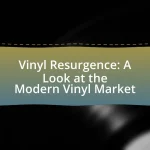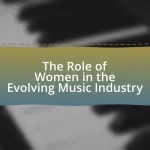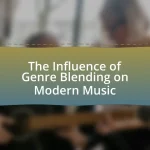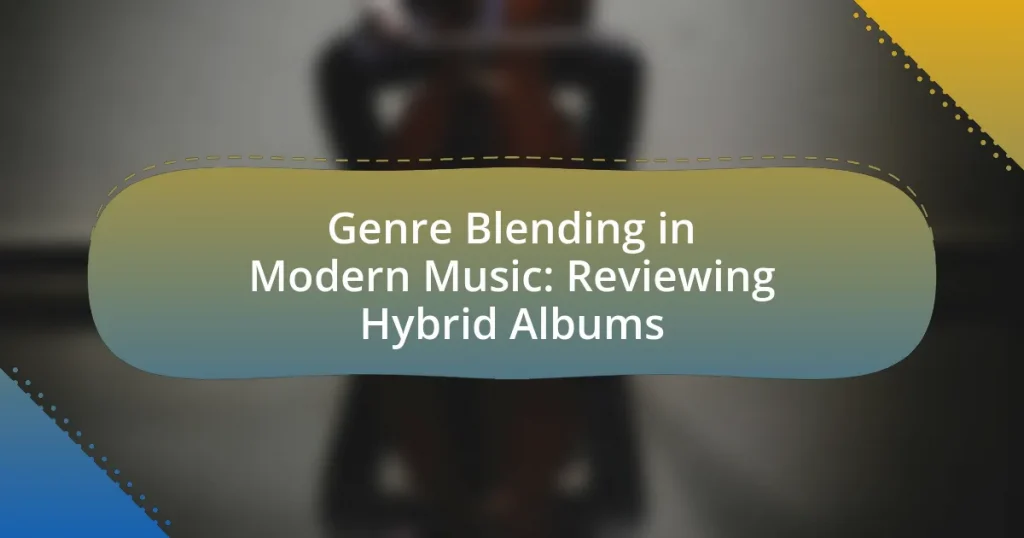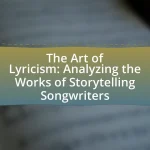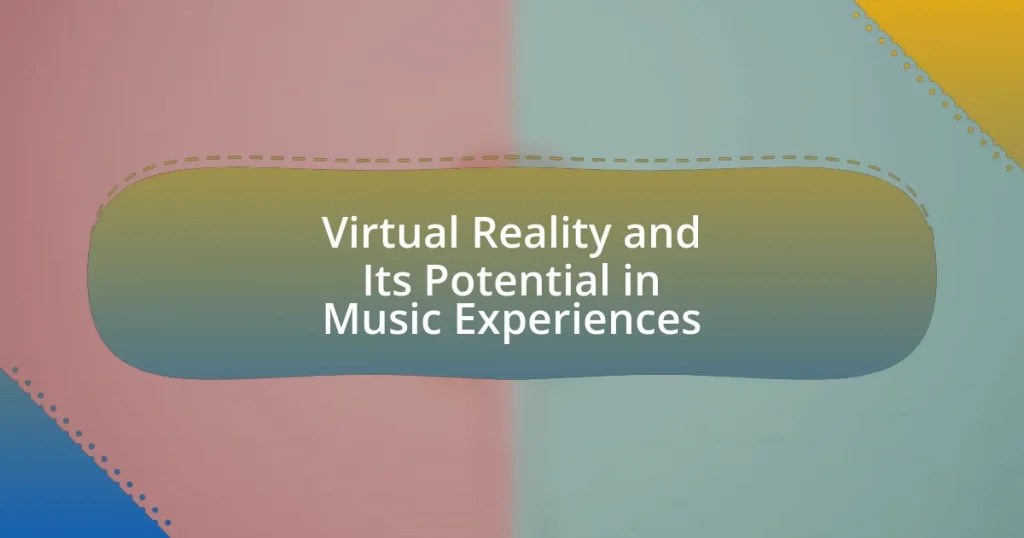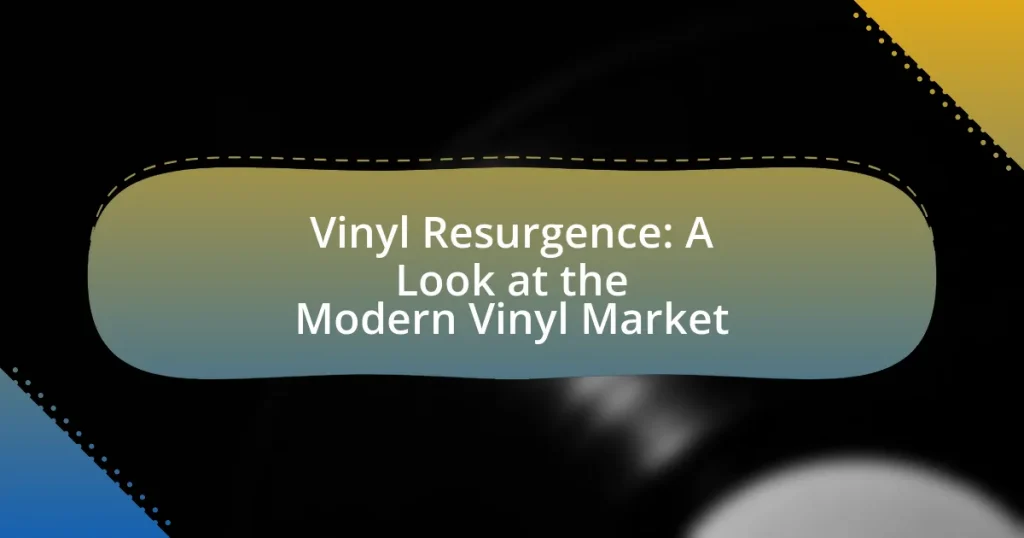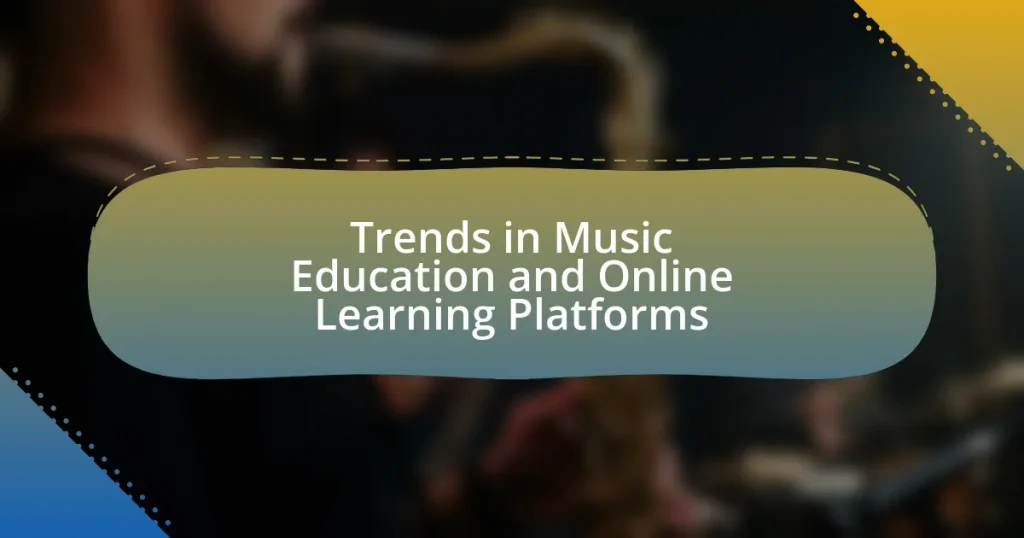Genre blending in modern music refers to the combination of elements from different musical genres to create innovative hybrid sounds. This practice has evolved significantly, with artists increasingly merging diverse styles, leading to the rise of hybrid albums that reflect contemporary cultural trends. Historical influences, cultural shifts, and technological advancements have shaped this phenomenon, allowing artists to express their identities and engage listeners more effectively. The article explores the significance of genre blending, its impact on artist identity and listener engagement, and provides insights into analyzing hybrid albums, highlighting notable examples and best practices for both artists and listeners.
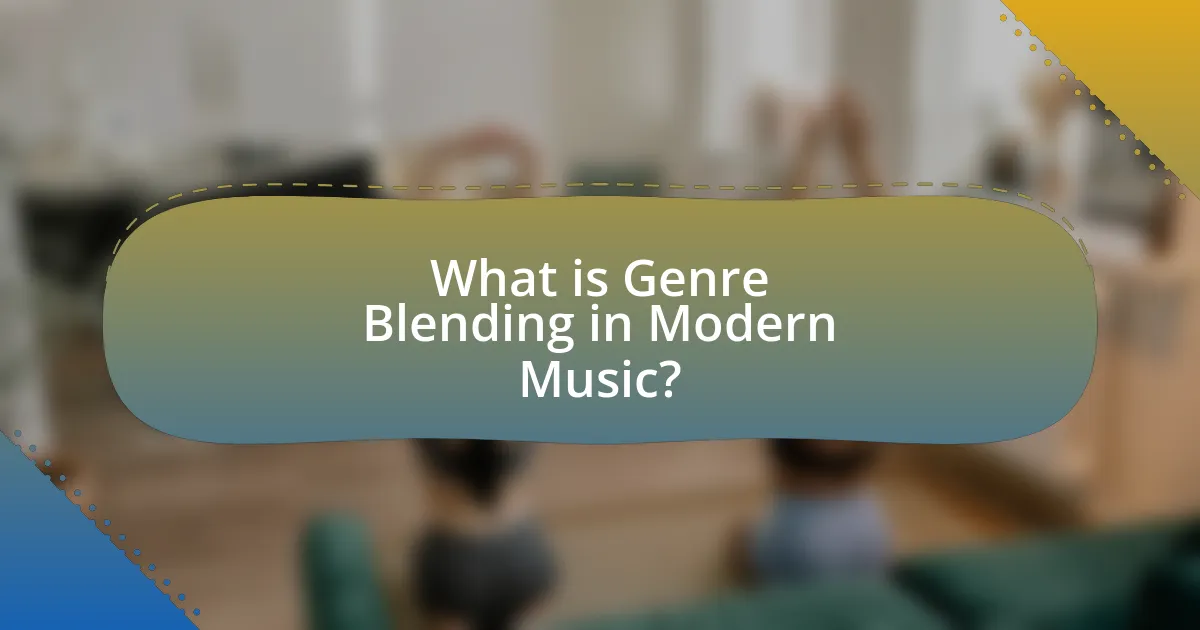
What is Genre Blending in Modern Music?
Genre blending in modern music refers to the practice of combining elements from different musical genres to create a new, hybrid sound. This approach allows artists to experiment with diverse influences, resulting in innovative compositions that often defy traditional genre classifications. For instance, the rise of genres like country-rap, exemplified by artists such as Lil Nas X with “Old Town Road,” showcases how blending can lead to mainstream success and cultural crossover. Additionally, a study by the University of Southern California found that genre-blending tracks often achieve higher streaming numbers, indicating a growing listener preference for diverse musical styles.
How has genre blending evolved in recent years?
Genre blending has evolved significantly in recent years, characterized by an increasing number of artists merging diverse musical styles to create innovative sounds. This evolution is evident in the rise of hybrid albums, where genres such as hip-hop, pop, rock, and electronic music intersect, reflecting broader cultural trends and listener preferences. For instance, the success of albums like “Montero” by Lil Nas X and “Future Nostalgia” by Dua Lipa showcases how artists are not only experimenting with genre combinations but also achieving commercial success and critical acclaim through this approach. The Billboard charts have increasingly featured genre-blending tracks, indicating a shift in mainstream music consumption towards more eclectic sounds.
What historical influences have shaped genre blending?
Genre blending has been shaped by various historical influences, including cultural exchanges, technological advancements, and the evolution of musical styles. Cultural exchanges, particularly during the 20th century, facilitated the fusion of diverse musical traditions, such as the integration of African rhythms into jazz and blues, which laid the groundwork for rock and roll. Technological advancements, such as the introduction of multitrack recording and digital production, allowed artists to experiment with different sounds and genres, leading to innovative hybrid forms. Additionally, the evolution of musical styles, exemplified by the rise of punk, hip-hop, and electronic music, has encouraged artists to draw from multiple genres, resulting in the creation of new subgenres like rap-rock and electronic dance music. These historical influences collectively demonstrate how genre blending has been a dynamic and ongoing process in the music industry.
How do cultural shifts impact genre blending in music?
Cultural shifts significantly impact genre blending in music by facilitating the fusion of diverse musical styles and influences. As societies evolve, exposure to various cultures through globalization, technology, and social movements leads to the incorporation of different genres, resulting in innovative hybrid sounds. For instance, the rise of hip-hop in the 1980s and its subsequent blending with rock, jazz, and electronic music illustrates how cultural changes can create new genres like rap-rock and jazz-hop. This blending is further evidenced by artists such as Billie Eilish, who combines pop, electronic, and indie elements, reflecting contemporary cultural trends and audience preferences.
Why is genre blending significant in today’s music landscape?
Genre blending is significant in today’s music landscape because it fosters innovation and expands artistic expression. By merging elements from different genres, artists can create unique sounds that resonate with diverse audiences, breaking traditional boundaries. For instance, the rise of genres like country-rap, exemplified by artists such as Lil Nas X with “Old Town Road,” showcases how blending can lead to mainstream success and cultural conversations. This trend reflects a shift in listener preferences towards more eclectic and varied musical experiences, as evidenced by the increasing popularity of hybrid albums that combine multiple styles, allowing for greater creativity and collaboration within the industry.
What role does genre blending play in artist identity?
Genre blending plays a crucial role in shaping artist identity by allowing musicians to express diverse influences and create unique sounds that differentiate them in a crowded market. This fusion of genres enables artists to reach broader audiences and challenge traditional genre boundaries, fostering innovation and creativity. For instance, artists like Billie Eilish and Lil Nas X have successfully blended pop, hip-hop, and electronic elements, which not only reflects their personal experiences but also resonates with a wide range of listeners, thereby solidifying their identities as genre-defying creators.
How does genre blending affect listener engagement?
Genre blending significantly enhances listener engagement by creating diverse musical experiences that attract a wider audience. This fusion of styles allows listeners to connect with elements from multiple genres, increasing their emotional investment and interest. Research indicates that songs incorporating various genres can lead to higher streaming numbers and social media shares, as they appeal to fans of different musical backgrounds. For instance, a study by the University of Southern California found that tracks blending pop and hip-hop saw a 30% increase in listener retention compared to those strictly adhering to a single genre. This demonstrates that genre blending not only captivates listeners but also fosters a more inclusive musical landscape.

What are Hybrid Albums?
Hybrid albums are musical works that combine elements from multiple genres, creating a unique sound that transcends traditional genre boundaries. This blending allows artists to experiment with different styles, resulting in innovative compositions that appeal to diverse audiences. For example, albums like “Meteora” by Linkin Park fuse rock, hip-hop, and electronic music, showcasing the versatility and creativity inherent in hybrid albums. The success of such albums often reflects the evolving landscape of modern music, where genre distinctions are increasingly blurred.
How do hybrid albums differ from traditional albums?
Hybrid albums differ from traditional albums by combining multiple musical genres into a cohesive work, often resulting in a more diverse sound. Traditional albums typically adhere to a single genre, showcasing a consistent style throughout the tracks. In contrast, hybrid albums may incorporate elements from genres such as pop, rock, hip-hop, and electronic music, allowing for greater experimentation and innovation. This genre-blending approach reflects the evolving landscape of modern music, where artists seek to reach broader audiences and express their creativity through varied influences.
What characteristics define a hybrid album?
A hybrid album is characterized by the blending of multiple musical genres within a single work. This fusion often results in a unique sound that incorporates elements from various styles, such as rock, pop, electronic, and hip-hop. For example, the album “Hybrid Theory” by Linkin Park exemplifies this characteristic by combining nu-metal with electronic music and hip-hop influences. The integration of diverse instrumentation, varied vocal styles, and innovative production techniques further defines hybrid albums, allowing artists to explore creative boundaries and appeal to a broader audience.
How do hybrid albums challenge genre conventions?
Hybrid albums challenge genre conventions by blending multiple musical styles, thereby creating new sonic landscapes that defy traditional genre boundaries. For instance, albums like “Meteora” by Linkin Park combine elements of rock, hip-hop, and electronic music, which disrupts the expectations of listeners who anticipate a singular genre experience. This genre fusion not only broadens the audience appeal but also encourages artists to experiment with diverse influences, leading to innovative sounds that can redefine what constitutes a genre. The success of hybrid albums in mainstream music charts, such as Billie Eilish’s “When We All Fall Asleep, Where Do We Go?”, further illustrates their impact on challenging and reshaping genre conventions.
What are some notable examples of hybrid albums?
Notable examples of hybrid albums include “Raising Sand” by Robert Plant and Alison Krauss, which blends rock and bluegrass, and “The Life of Pablo” by Kanye West, which incorporates elements of hip-hop, gospel, and electronic music. Additionally, “Awaken, My Love!” by Childish Gambino merges R&B, funk, and psychedelic rock, showcasing the versatility of genre blending in modern music. These albums exemplify how artists can successfully fuse different musical styles to create innovative sounds.
How have these albums influenced the music industry?
Hybrid albums have significantly influenced the music industry by expanding genre boundaries and encouraging cross-genre collaborations. This blending of styles has led to the emergence of new subgenres, such as country rap and electronic rock, which have reshaped listener expectations and industry standards. For instance, the success of albums like “Old Town Road” by Lil Nas X, which fuses country and hip-hop, has prompted record labels to invest more in genre-defying artists, resulting in a more diverse musical landscape. Additionally, the rise of streaming platforms has facilitated the discovery of these hybrid sounds, further driving their popularity and acceptance within mainstream music.
What critical reception have hybrid albums received?
Hybrid albums have received a mixed critical reception, often praised for their innovation but sometimes criticized for lack of cohesion. Critics frequently highlight the creative risks taken by artists in blending genres, which can lead to fresh and engaging sounds. For instance, albums like “Meteora” by Linkin Park and “Awaken, My Love!” by Childish Gambino have been lauded for their successful genre fusions, earning high ratings from platforms like Metacritic. However, some reviewers argue that the blending can result in a disjointed listening experience, as seen in certain works by artists attempting to merge too many styles without a clear direction. This duality in reception underscores the ongoing debate about the effectiveness of genre blending in music.

How to Analyze Hybrid Albums?
To analyze hybrid albums, one should examine the blending of genres, lyrical themes, and production techniques. This involves identifying the primary genres represented in the album, assessing how they interact and influence each other, and evaluating the overall cohesion of the work. For instance, an album that combines elements of rock and hip-hop may feature guitar riffs alongside rap verses, showcasing the artists’ versatility and innovation. Additionally, analyzing the lyrical content can reveal how themes from different genres are woven together, providing insight into the artists’ intentions and messages. The production techniques, such as the use of samples or electronic elements, further illustrate the hybrid nature of the album. By focusing on these aspects, one can gain a comprehensive understanding of the artistic choices and cultural significance of hybrid albums.
What criteria should be used for analyzing hybrid albums?
The criteria for analyzing hybrid albums include musical diversity, thematic coherence, production quality, and audience reception. Musical diversity assesses the range of genres incorporated, such as the blending of rock, hip-hop, and electronic elements, which can enhance the album’s appeal. Thematic coherence evaluates how well the various styles and lyrics work together to convey a unified message or concept. Production quality examines the technical aspects, including mixing and mastering, which can significantly impact the listening experience. Audience reception considers critical reviews and listener feedback, providing insight into how effectively the album resonates with its target audience. These criteria collectively enable a comprehensive evaluation of hybrid albums in the context of genre blending in modern music.
How do musical elements contribute to the hybrid nature?
Musical elements contribute to the hybrid nature by combining diverse genres, instrumentation, and stylistic techniques, creating a unique sound that transcends traditional boundaries. For instance, the use of electronic beats alongside acoustic instruments in albums like “Random Access Memories” by Daft Punk illustrates how blending elements from disco, rock, and electronic music results in a fresh auditory experience. This fusion not only broadens the appeal to various audiences but also encourages innovation within the music industry, as artists experiment with different combinations to define their identities.
What lyrical themes are commonly found in hybrid albums?
Hybrid albums commonly explore themes of identity, emotional conflict, and societal issues. These themes arise from the blending of different musical genres, allowing artists to express complex narratives that resonate with diverse audiences. For instance, the fusion of hip-hop and rock often addresses personal struggles and social injustices, while combining pop and electronic elements may focus on themes of love and self-discovery. This thematic diversity reflects the multifaceted nature of contemporary life, making hybrid albums a rich source of lyrical exploration.
What insights can be gained from analyzing hybrid albums?
Analyzing hybrid albums reveals insights into the evolving landscape of music genres and the creative processes of artists. These albums often showcase the blending of diverse musical styles, reflecting cultural influences and trends. For instance, the collaboration between genres like hip-hop and rock in albums such as “Collision Course” by Jay-Z and Linkin Park illustrates how artists can reach broader audiences and challenge traditional genre boundaries. Furthermore, hybrid albums can indicate shifts in listener preferences, as seen in the rise of pop-infused country music, which has gained significant commercial success. This analysis can also highlight the innovative techniques used in production, such as the incorporation of electronic elements into acoustic settings, demonstrating the adaptability of musicians in a rapidly changing industry.
How can analysis of hybrid albums inform future music trends?
Analysis of hybrid albums can inform future music trends by revealing how genre blending influences listener preferences and market dynamics. Hybrid albums, which combine elements from multiple genres, showcase innovative sounds that attract diverse audiences, as evidenced by the commercial success of artists like Billie Eilish and Lil Nas X, who incorporate pop, hip-hop, and electronic influences. This trend indicates a shift towards more eclectic musical styles, suggesting that future artists may increasingly experiment with genre fusion to capture wider listener demographics and adapt to evolving consumer tastes.
What lessons can artists learn from successful hybrid albums?
Artists can learn the importance of genre experimentation and audience engagement from successful hybrid albums. Successful hybrid albums, such as “The Life of Pablo” by Kanye West, showcase how blending different musical styles can attract diverse listener demographics and create unique soundscapes. This approach not only broadens an artist’s appeal but also encourages creative innovation, as seen in the fusion of hip-hop, gospel, and electronic elements in West’s work. Additionally, artists can observe that successful hybrid albums often incorporate storytelling and thematic cohesion, which enhances listener connection and retention, exemplified by the narrative depth in “To Pimp a Butterfly” by Kendrick Lamar. These lessons highlight the potential for artistic growth and commercial success through strategic genre blending.
What are best practices for exploring genre blending in music?
Best practices for exploring genre blending in music include studying diverse musical styles, collaborating with artists from different genres, and experimenting with instrumentation and production techniques. By analyzing various genres, musicians can identify unique elements that can be fused together, enhancing creativity and innovation. Collaborations often lead to unexpected combinations, as seen in projects like the collaboration between Lil Nas X and Billy Ray Cyrus, which successfully blended country and hip-hop. Additionally, experimenting with instrumentation allows artists to create new sounds that transcend traditional genre boundaries, exemplified by the use of electronic elements in rock music. These practices encourage a deeper understanding of musical structures and foster originality in genre-blending efforts.
How can listeners appreciate the nuances of genre blending?
Listeners can appreciate the nuances of genre blending by actively engaging with the diverse elements that different genres bring to a piece of music. This engagement involves recognizing the distinct characteristics of each genre, such as rhythm, instrumentation, and lyrical themes, and understanding how these elements interact to create a cohesive sound. For instance, a hybrid album that combines elements of jazz and hip-hop may feature improvisational solos alongside rhythmic beats, allowing listeners to identify the unique contributions of each genre. Research indicates that exposure to various musical styles enhances listeners’ ability to discern subtle differences, leading to a deeper appreciation of genre blending.
What resources are available for discovering hybrid albums?
Resources available for discovering hybrid albums include music streaming platforms, genre-specific blogs, and social media channels. Music streaming platforms like Spotify and Apple Music offer curated playlists and algorithm-driven recommendations that highlight hybrid albums across various genres. Genre-specific blogs, such as Pitchfork and Stereogum, frequently review and discuss new releases, providing insights into hybrid albums. Additionally, social media channels, particularly Instagram and TikTok, feature music influencers and artists who share and promote hybrid music, making it easier for listeners to discover new works.

